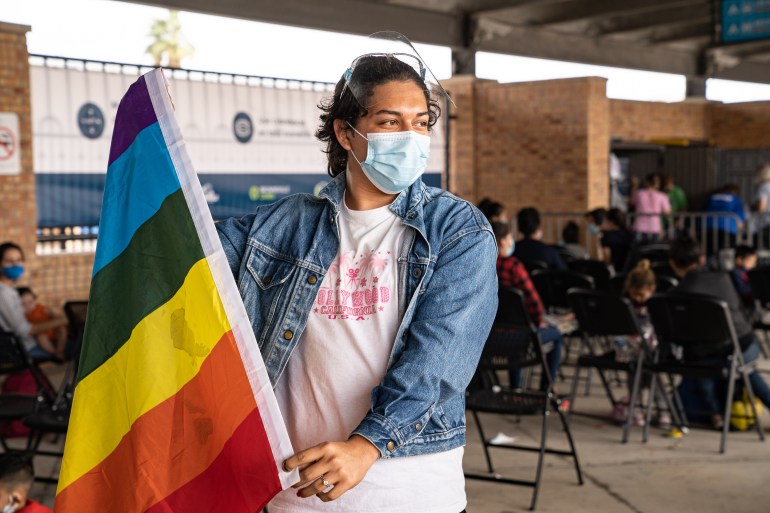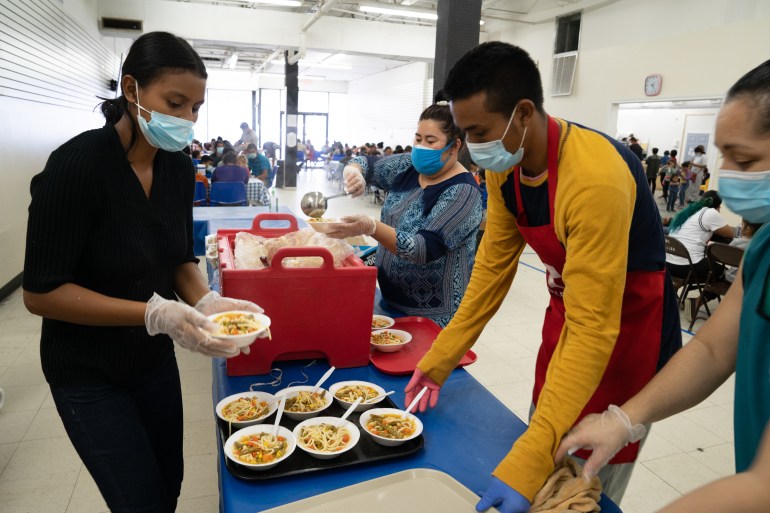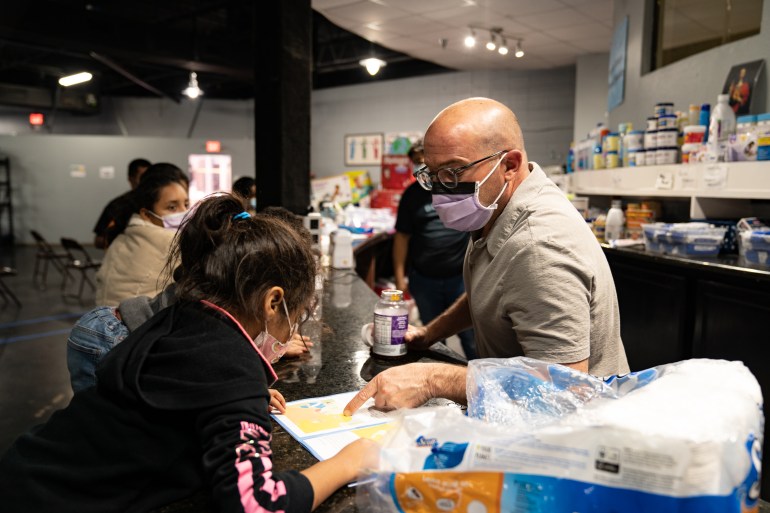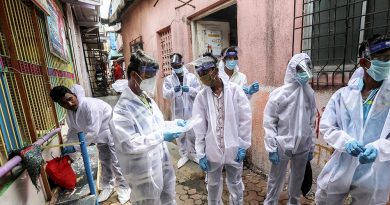Matamoros to the US: A long journey across a short bridge | Child Rights News
Matamoros, Mexico/Brownsville, Texas, US – Late last month in Matamoros, one of the asylum-seeker camps on the US-Mexico border, the usual hive of activity was gone and an air of nervous anticipation descended as the Mexican Migration Institute (INM) closed the tall razor-wire topped gates and all 700 residents were asked to wait in their tents for further information.
It was a day many had waited for in the primitive camp for 18 months or more – the opportunity to go to the United States to plead their asylum claims. The camp, which had sprung up just across the border swelled after the US under then-President Donald Trump, introduced the Migrant Protection Protocols (MPP) in 2019 which forced asylum seekers to wait for court cases in Mexico.
The atmosphere in the camp, always with an edge of violence and danger, worsened during the pandemic which limited the reach of aid workers reluctant to spread the virus. Camp residents faced risks of kidnap and rape.
But now, the US Department for Homeland Security had announced that it would be “processing” individuals for entry to the United States, under orders from newly elected US President Joe Biden to restore a “safe, orderly and humane immigration system”.
People stood in doorways to their tents passing pieces of gossip and questioning the process. Who would be let in? Was the camp being completely cleared out? What would happen to those left behind? The US rules said those with active MPP claims would be allowed entry.
Sister Norma Pimentel, the executive director of Catholic Charities, believes that all camp residents are “at risk and vulnerable” and therefore, everyone from the camp, regardless of MPP status, would be reviewed. “It is the worst place to be. Residents are kidnapped, extorted or even killed. Any place is safer than that”, she said.
United Nations staff moved from tent to tent, marking each person’s arm with a black marker and a UV pen, and giving each a wristband. They marked the tents with a number. The next step was to wait.
Xochlith, from Nicaragua, had been in the camp since the middle of 2019, with her two daughters, living in a tent opposite her mother, Perla. Neither woman wished to share their full names.
Perla said they fled political persecution. She had passed the time volunteering for the camp’s pharmacy. Xochilth had started her own restaurant, offering Nicaraguan and El Salvadorian dishes such as pupusas – fat corn pancakes filled with meat and cheese – cooked on a fire pit inside an old washing machine drum.
While waiting for the UN personnel to get to her tent, Xochilth fluttered her eyelashes and wore makeup in anticipation of finally crossing the border to the US.
Registration of the entire camp took less than a day and that evening February 24, the US Customs and Border Patrol (CPB) selected the first 27 people who would enter the US the following day.
The CBP administered COVID tests and registered personal details, and the first 27 from the camp arrived by bus at the Brownsville, Texas bus station. They had travelled no more than 600 metres but they were a world away from Matamoros.
 Fernanda, a transgender El Salvadorian who has just crossed the border into the US, holds up a pride flag to the cameras [Lexie Harrison-Cripps/Al Jazeera]
Fernanda, a transgender El Salvadorian who has just crossed the border into the US, holds up a pride flag to the cameras [Lexie Harrison-Cripps/Al Jazeera]One of the first people to cross was Fernanda, a transgender 17 year old woman who fled her home country of El Salvador. She waved a pride flag to the cameras as tears slid down her cheeks.
Fernanda stayed in a hotel overnight then flew to California, where she planned to stay with her aunt and hoped to return to school.
Xochlith, Perla and the children arrived in Texas soon after, then made their way to South Carolina.
In a Respite Center in McAllen, Texas, about an hour’s drive from Brownsville, those arriving from Matamoros mingled with others who had crossed the border on their own. Hundreds of people filled three large rooms. Young mothers and children under five made up most of those in the shelter.
A loud Tannoy announced taxi and bus rides or other services.
 People in the McAllen Respite Center hand out food to hundreds of hungry migrants who are staying there until they find a permanent place to stay in the United States. Many had just crossed from Matamoros, Mexico [Lexie Harrison-Cripps/Al Jazeera]
People in the McAllen Respite Center hand out food to hundreds of hungry migrants who are staying there until they find a permanent place to stay in the United States. Many had just crossed from Matamoros, Mexico [Lexie Harrison-Cripps/Al Jazeera]Josafina (a pseudonym), 23 from Honduras had arrived the previous night and had not slept much on the thin blue plastic mats that were spread across the crowded floor, but she did not mind. “It was a dream to leave Matamoros. I was so happy,” she said.
Her journey to the US had begun 15 months before with her five-year-old son. When the MPP rules kept her from entering the US, she found herself homeless on the streets of Matamoros city, then moved to a tent in the camp. Josafina’s son became sick and increasingly unhappy as she sought to “avoid the rape and kidnap risk”. She sent him across the border to the US with nothing in his pockets but her brother’s name and his Florida address.
“Nobody can understand what it is really like [in the camp,]” she said, her eyes filled with tears. “There was too much violence, with men beating and raping people and abusing children,” she added.
After three months, in Texas and then New York, her son was transferred to the custody of her brother in Florida, she told Al Jazeera.
“I almost lost my mind. For two and a half months, I saw a psychologist in the camp with Medicins Sans Frontiers. It helped, and bit by bit I got better,” she said.
She planned to take a bus that night. “I’ll arrive after he has gone to school so I will surprise him when he gets home,” she said with excited eyes.
Al Jazeera has been unable to confirm if the reunion has taken place.
Playing their flute in thanksgiving! A whole family from the refugee camp Matamoros feel blessed that after so many months they are finally in the US! ♥️ pic.twitter.com/BUMvRfsAFl
— Norma Seni Pimentel (@nspimentel) February 27, 2021
By March 4, more than 650 people had left the Matamoros camp and been allowed into the US, according to UN agencies working there. There are currently more than 50 people remaining in the camp, although the UN confirmed that it expects more people will leave for the US.
US Customs and Border Patrol would not comment on the selection and approval process that chose those who could leave, but Al Jazeera confirmed at least one person without an active MPP case had been allowed into the US. Organisations working to process the asylum seekers could not give numbers on how many of those who crossed the border had active cases, or how many had been denied entry.
Many of the grassroots organisations that had been offering support believe that the camp will be closed down entirely, INM the Mexican government department managing the camp, declined to comment.
“The conditions in the camp are horrid,” said Helen Perry, executive director of Global Response Management (GRM), an NGO with a presence in Matamoros since October 2019.
 A doctor hands out vitamins to children at the counter of the free store in the shelter [Lexie Harrison-Cripps/Al Jazeera]
A doctor hands out vitamins to children at the counter of the free store in the shelter [Lexie Harrison-Cripps/Al Jazeera]GRM staff entered the camp Thursday and found the remaining residents are “lacking access to food, water and sanitation” she said. “On top of that, every day between 50 and 100 people are coming to the camp and asking to be let in because there are inadequate shelter beds in Matamoros city.”
“There is raw standing sewage in the drainage ditches and people are back to spontaneous defecation,” she added.
Perry, acknowledged the dangers that were associated with the camp. However, she said that “[it] provided an infrastructure that gave access to legal, medical and other services. We are concerned about how to get the resources to other parts of the city [if the camp closes.]”

